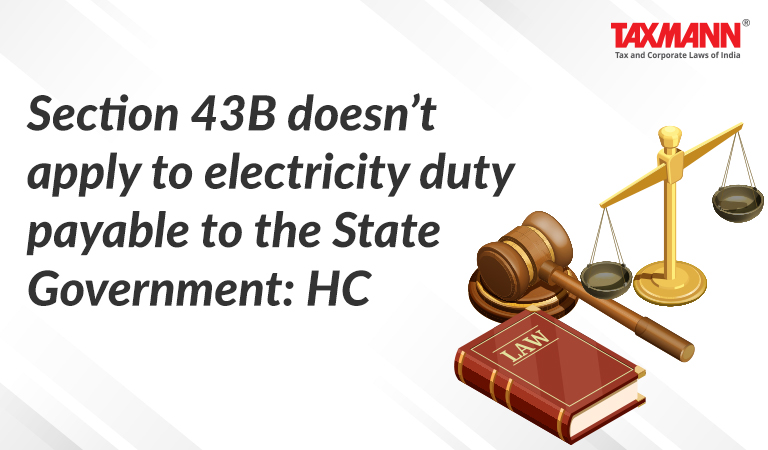Section 43B doesn’t apply to electricity duty payable to the State Government: HC
- Blog|News|Income Tax|
- 2 Min Read
- By Taxmann
- |
- Last Updated on 20 January, 2023
Case Details: PCIT v. Dakshin Haryana Bijli Vitran Nigam Ltd. - [2023] 146 taxmann.com 14 (Punjab & Haryana)
Judiciary and Counsel Details
-
- Tejinder Singh Dhindsa & Pankaj Jain, JJ.
- Vaibhav Gupta, Jr. Standing Counsel for the Appellant.
Facts of the Case
The assessee was a licensee under the Electricity Act, of 2003, engaged in the distribution of power in the State. The assessee declared NIL income and the same was accepted.
Later, the CIT revised the assessment exercising power under section 263 and made disallowance of electricity duty collected by the assessee as per the provisions of the Punjab Electricity (Duty) Act, 1958.
The lower authorities deleted the additions. The matter reached to High Court.
High Court Held
The High Court held that section 4 of the Punjab Electricity Act casts a duty on the licensee to collect the electricity duty from the consumers and to pay the same to the State Government. Licensee is only a collecting agency.
Thus, the amount collected by the licensee as electricity duty leviable under the 1958 Act is required to be deposited in the Government treasury by the licensee.
Section 43B is a non obstente clause that was inserted by the Finance Act, 1983 with an intent to curb the malpractice.
The revenue is required to show that the duty, tax, cess, or fee (in the instant case electricity duty) is payable by the assessee. In the instant case, there is no such provision contained in the 1958 Act that shows that the liability to pay the electricity duty rests upon the assessee. Rather section 4 of the 1958 Act read with provisions contained in the 1958 Rules makes it abundantly clear that the assessee is merely an agency assigned with a statutory function to collect electricity duty from the consumers and to pay the same to the State Government.
Thus, the provisions of section 43B would not get attracted to electricity duty paid by the assessee.
List of Cases Reviewed
-
- CESE Ltd. v. CIT [2015] 61 taxmann.com 92/235 Taxman 6/280 CTR 501 (Cal.) (para 14) followed.
- CIT v. Ahmedabad Electricity Co. Ltd. [2003] 129 Taxman 190/262 ITR 97/181 CTR 222 (Guj.) (para 14) distinguished.
- Pr. CIT v. Dakshin Haryana Bijli Vitran Nigam Ltd. Order dated 19-2-2020 (para 15) affirmed.
List of Cases Referred to
-
- CIT v. Ahmedabad Electricity Co. Ltd. [2003] 129 Taxman 190/262 ITR 97/181 CTR 222 (Guj.) (para 5)
- CESE Ltd. v. CIT [2015] 61 taxmann.com 92/235 Taxman 6/280 CTR 501 (Cal.) (para 14).
Disclaimer: The content/information published on the website is only for general information of the user and shall not be construed as legal advice. While the Taxmann has exercised reasonable efforts to ensure the veracity of information/content published, Taxmann shall be under no liability in any manner whatsoever for incorrect information, if any.

Taxmann Publications has a dedicated in-house Research & Editorial Team. This team consists of a team of Chartered Accountants, Company Secretaries, and Lawyers. This team works under the guidance and supervision of editor-in-chief Mr Rakesh Bhargava.
The Research and Editorial Team is responsible for developing reliable and accurate content for the readers. The team follows the six-sigma approach to achieve the benchmark of zero error in its publications and research platforms. The team ensures that the following publication guidelines are thoroughly followed while developing the content:
- The statutory material is obtained only from the authorized and reliable sources
- All the latest developments in the judicial and legislative fields are covered
- Prepare the analytical write-ups on current, controversial, and important issues to help the readers to understand the concept and its implications
- Every content published by Taxmann is complete, accurate and lucid
- All evidence-based statements are supported with proper reference to Section, Circular No., Notification No. or citations
- The golden rules of grammar, style and consistency are thoroughly followed
- Font and size that’s easy to read and remain consistent across all imprint and digital publications are applied






 CA | CS | CMA
CA | CS | CMA


